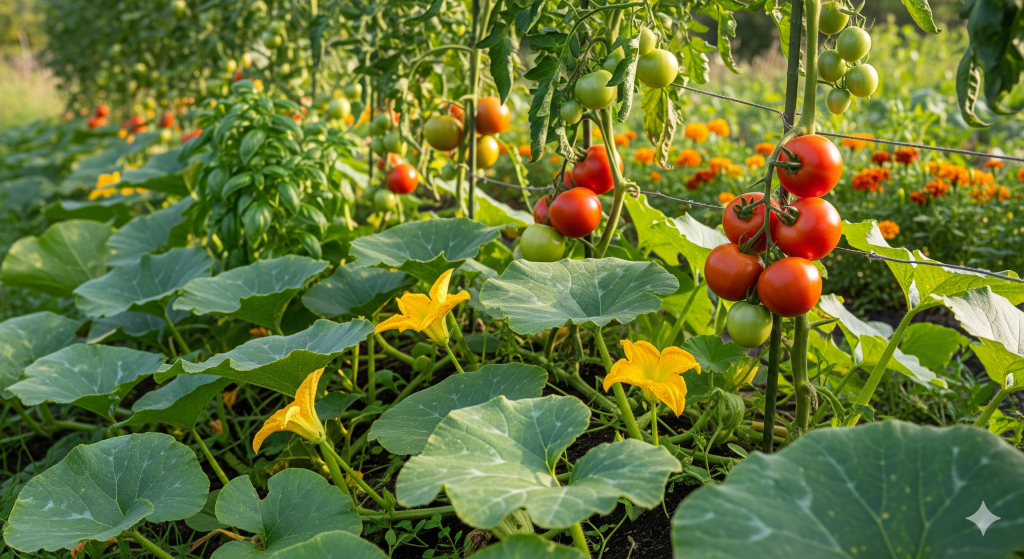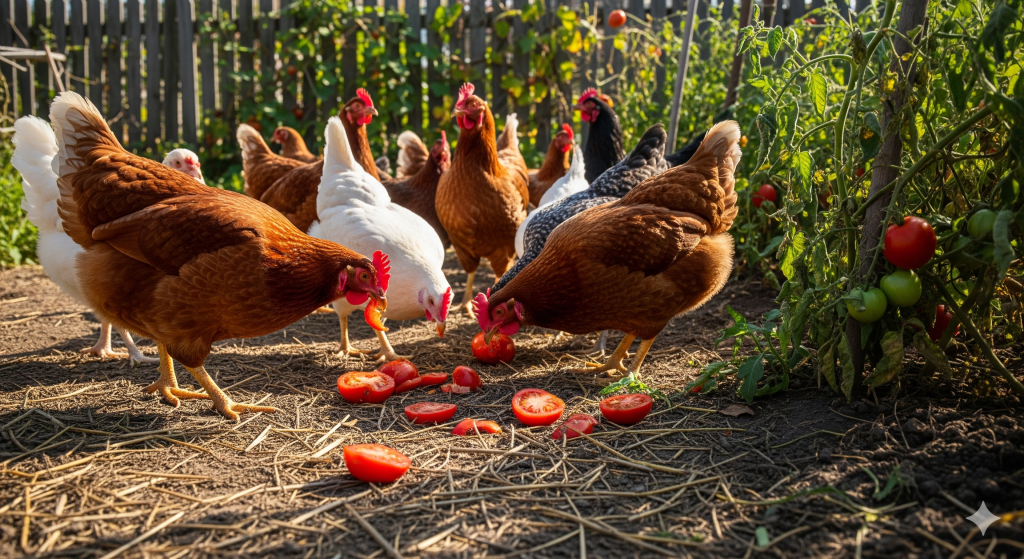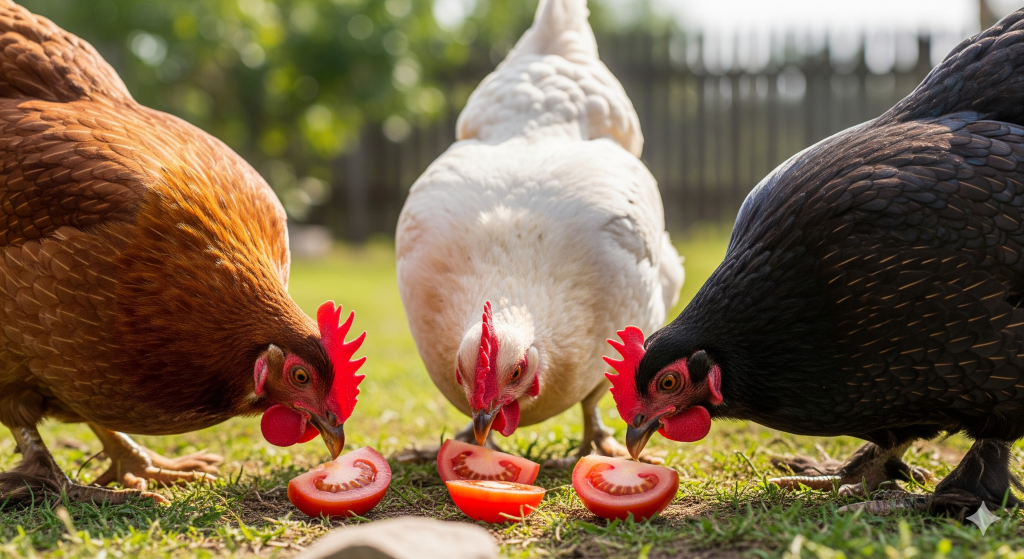Table of Contents
In the quest for a lush, productive, and harmonious garden, companion planting is a gardener’s most powerful strategy. By pairing plants that benefit one another, we can create a resilient ecosystem. A common question for those cultivating a summer vegetable garden is whether two popular, large-scale plants—pumpkins and tomatoes—can be grown together. Can these two garden giants coexist peacefully?
The answer is yes, they can, but this partnership requires careful planning and active management. While not a traditional companion pairing, planting tomatoes and pumpkins together can offer unique benefits. However, their vigorous growth habits mean you cannot simply plant them and walk away. Success hinges on understanding how to leverage their strengths while mitigating their significant challenges, primarily the intense competition for space, sunlight, and nutrients.
This guide will explore the benefits and drawbacks of this pairing, providing the strategies you need to successfully grow these two staples side-by-side.
Benefits of Planting Tomatoes and Pumpkins Together
At first glance, these two seem like rivals. However, when managed correctly, pumpkins can provide a unique service to your tomato plants, acting as a dynamic and productive ground cover.
- Living Mulch: This is the primary benefit of the partnership. Pumpkin vines grow quickly, and their large, broad leaves spread across the soil surface. This creates a “living mulch” that shades the soil. During the peak heat of summer, this is incredibly valuable. It helps to keep the soil cool, dramatically reduces water evaporation, and protects the delicate soil microbiome from being baked by the sun.
- Weed Suppression: The dense canopy of pumpkin leaves effectively blocks sunlight from reaching the ground, which naturally and effectively suppresses the growth of weeds. This means less competition for your hungry tomato plants and less time spent on the tedious task of weeding.
- Improved Biodiversity: Planting a variety of crops in a single bed creates a more diverse and resilient garden ecosystem. This can help to confuse pests that are typically drawn to a large monoculture of a single plant type. The large, yellow pumpkin blossoms are also excellent at attracting pollinators to the garden, which can benefit all surrounding plants.
Want the Ultimate Guide to Off-Grid Living?

If you love the self-sufficient lifestyle, this is the only guide you’ll ever need. Learn how to generate your own power, secure your water supply, and become truly independent. No fluff, just actionable plans.
➡️ Check out The Self-Sufficient Backyard and start your journey today!
Keys to Success: Managing the Challenges
To prevent this partnership from turning into a garden battleground, you must proactively manage the challenges. Their compatibility is not passive; it must be actively maintained throughout the growing season.
- Aggressive Sprawling and Space: Pumpkin vines are notoriously aggressive. If left unchecked, they will climb over and completely smother your tomato plants.
- Solution: Give your tomatoes a head start. Plant your tomato seedlings and allow them to become well-established (at least a foot tall) before planting pumpkin seeds or seedlings nearby. As the pumpkin vines begin to run, actively train them to grow away from the tomatoes, directing them into open areas of the garden.
- Sunlight Competition: Tomatoes need at least 6-8 hours of direct sun to thrive. The large leaves of a pumpkin plant can easily create too much shade, stunting the tomato’s growth and reducing fruit production.
- Solution: Position your plants strategically. Plant the tomatoes on the north side of the pumpkins (in the Northern Hemisphere). This ensures the sun, which travels across the southern sky, will hit the tomatoes first. You may also need to selectively prune a few of the largest pumpkin leaves if they are directly shading the tomato plants.
- Nutrient and Water Competition: Both tomatoes and pumpkins are “heavy feeders,” meaning they have a huge appetite for nutrients and water. Planting them together creates intense competition.
- Solution: Prepare the soil lavishly. Before planting, amend the bed with a very generous amount of high-quality compost or well-rotted manure. You will need to be diligent about providing consistent, deep watering to the entire bed and plan on applying a balanced liquid fertilizer every few weeks to meet the high demands of both crops.
- Pest and Disease Management: The dense foliage of pumpkin vines can trap moisture and reduce air circulation around the base of your tomato plants. In humid climates, this creates a perfect breeding ground for fungal diseases like blight.
Solution: Pruning is key. As mentioned, selectively remove some pumpkin leaves to improve airflow. Water both plants at the base, using a soker hose or watering can, and avoid getting the foliage wet. Always water in the morning so the sun has time to dry any residual moisture.
Bad Companion Plants for Pumpkins
While pumpkins can be paired with tomatoes under the right conditions, there are a few plants they should generally avoid.
- Potatoes: Potatoes are heavy feeders and can attract potato beetles, which can sometimes cause problems for the pumpkin family.
- Other Vining Crops: Planting pumpkins too close to other large, vining members of the squash family (like other pumpkins or melons) is generally not recommended. This can concentrate pests and diseases specific to that family and lead to an unmanageable tangle of vines.
- Strong Aromatic Herbs: Some anecdotal evidence suggests that planting very strong herbs like rosemary or sage directly next to pumpkins can slightly affect their growth or flavor, though this is not a major concern.
Conclusion
So, can you plant tomatoes and pumpkins together? Yes, this unconventional duo can form a successful and productive partnership in your garden. The pumpkin acts as a powerful living mulch, protecting the soil from the summer sun and suppressing weeds, while the tomato reaches for the sky.
However, this is not a low-maintenance arrangement. It is a pairing best suited for the attentive gardener who has ample space and is willing to actively manage the plants’ growth, nutritional needs, and ensure good air circulation. For beginners or those with smaller garden plots, it may be wiser to give these two giants their own separate spaces. But for those who embrace the challenge, the reward is a lush, multi-layered, and incredibly productive garden bed that showcases the power of strategic companion planting.



